Economics of Construction: Analysis of Australian Economy and Construction Industry Sectors
VerifiedAdded on 2023/06/05
|16
|4175
|343
AI Summary
This report analyzes the Australian economy's performance over the past 5 years, identifies different sectors of the construction industry, and explains how the construction industry has contributed to the Australian economy. It also includes a report to the client on the performance of the engineering construction sector compared to other sectors over the past 5 years and identification of sectors with high growth opportunities.
Contribute Materials
Your contribution can guide someone’s learning journey. Share your
documents today.
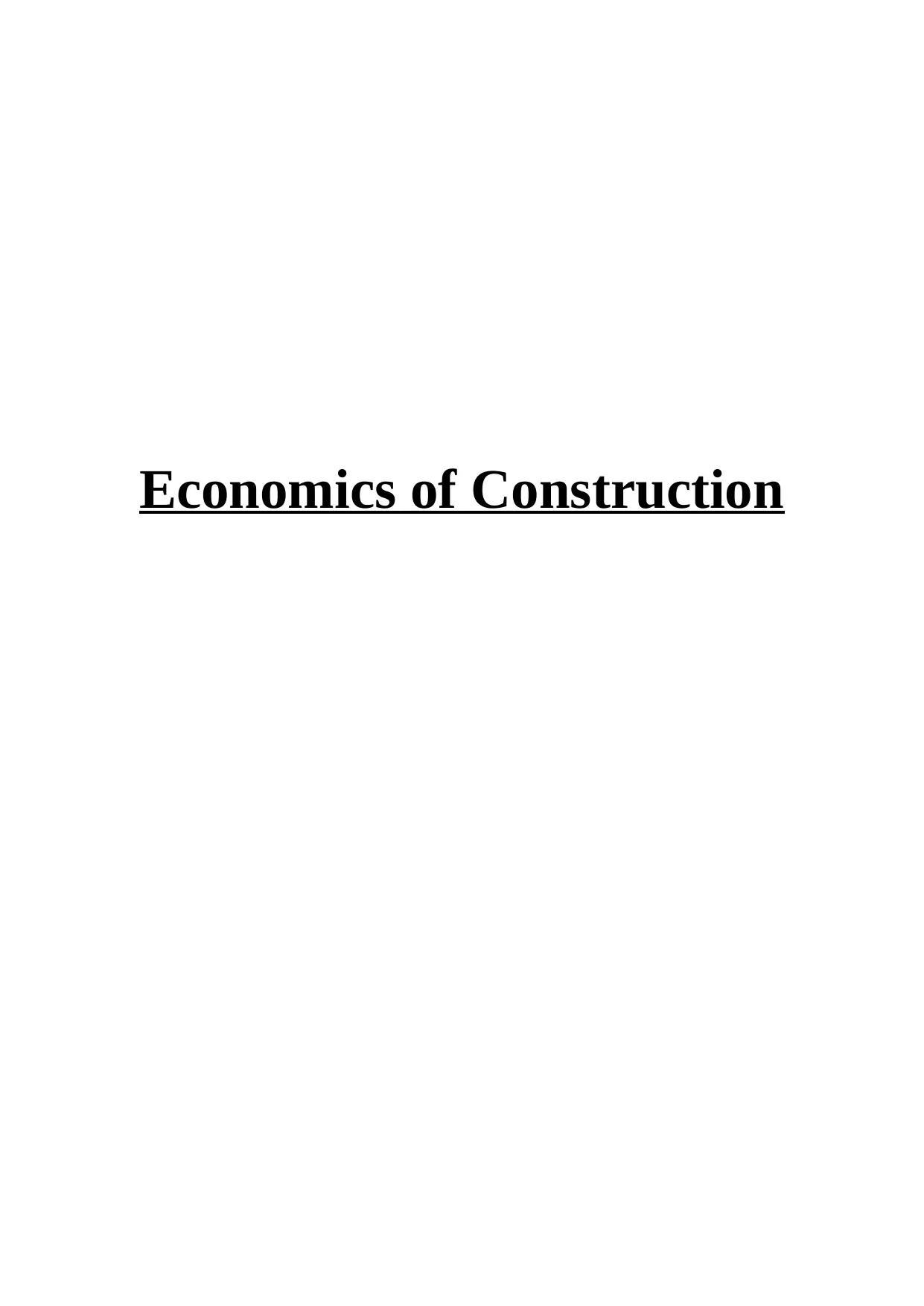
Economics of Construction
Secure Best Marks with AI Grader
Need help grading? Try our AI Grader for instant feedback on your assignments.
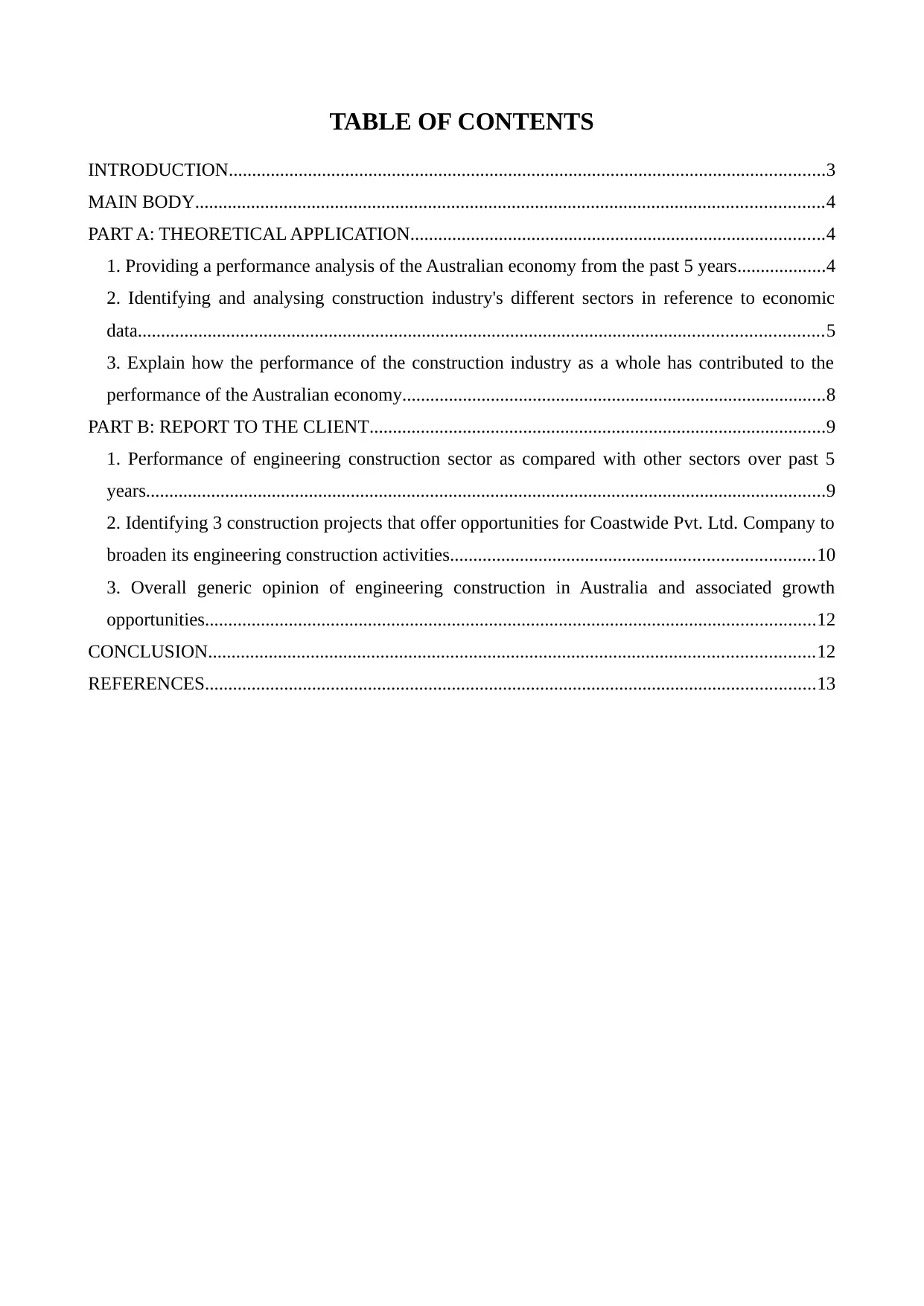
TABLE OF CONTENTS
INTRODUCTION................................................................................................................................3
MAIN BODY.......................................................................................................................................4
PART A: THEORETICAL APPLICATION.........................................................................................4
1. Providing a performance analysis of the Australian economy from the past 5 years...................4
2. Identifying and analysing construction industry's different sectors in reference to economic
data...................................................................................................................................................5
3. Explain how the performance of the construction industry as a whole has contributed to the
performance of the Australian economy...........................................................................................8
PART B: REPORT TO THE CLIENT..................................................................................................9
1. Performance of engineering construction sector as compared with other sectors over past 5
years..................................................................................................................................................9
2. Identifying 3 construction projects that offer opportunities for Coastwide Pvt. Ltd. Company to
broaden its engineering construction activities..............................................................................10
3. Overall generic opinion of engineering construction in Australia and associated growth
opportunities...................................................................................................................................12
CONCLUSION..................................................................................................................................12
REFERENCES...................................................................................................................................13
INTRODUCTION................................................................................................................................3
MAIN BODY.......................................................................................................................................4
PART A: THEORETICAL APPLICATION.........................................................................................4
1. Providing a performance analysis of the Australian economy from the past 5 years...................4
2. Identifying and analysing construction industry's different sectors in reference to economic
data...................................................................................................................................................5
3. Explain how the performance of the construction industry as a whole has contributed to the
performance of the Australian economy...........................................................................................8
PART B: REPORT TO THE CLIENT..................................................................................................9
1. Performance of engineering construction sector as compared with other sectors over past 5
years..................................................................................................................................................9
2. Identifying 3 construction projects that offer opportunities for Coastwide Pvt. Ltd. Company to
broaden its engineering construction activities..............................................................................10
3. Overall generic opinion of engineering construction in Australia and associated growth
opportunities...................................................................................................................................12
CONCLUSION..................................................................................................................................12
REFERENCES...................................................................................................................................13
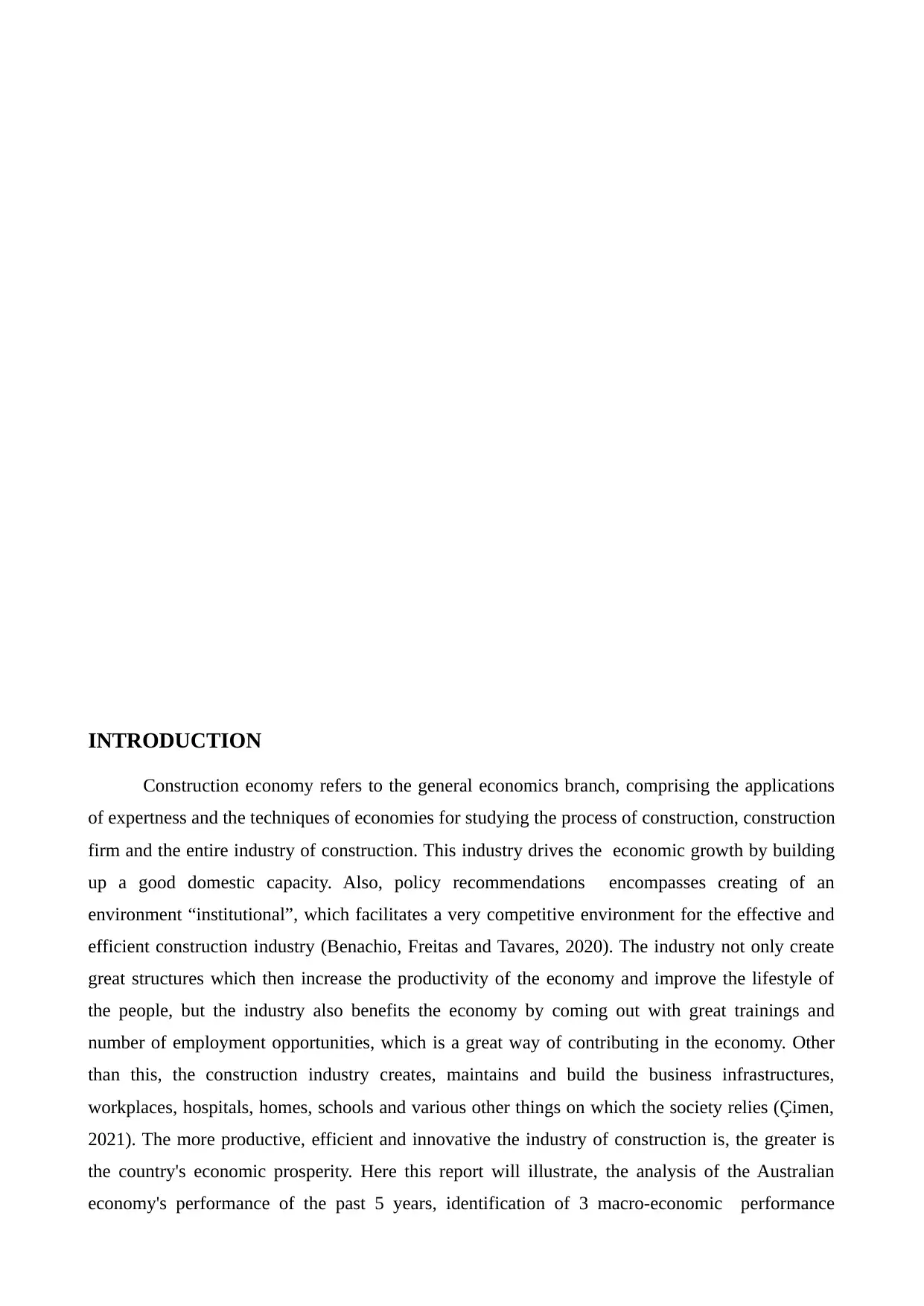
INTRODUCTION
Construction economy refers to the general economics branch, comprising the applications
of expertness and the techniques of economies for studying the process of construction, construction
firm and the entire industry of construction. This industry drives the economic growth by building
up a good domestic capacity. Also, policy recommendations encompasses creating of an
environment “institutional”, which facilitates a very competitive environment for the effective and
efficient construction industry (Benachio, Freitas and Tavares, 2020). The industry not only create
great structures which then increase the productivity of the economy and improve the lifestyle of
the people, but the industry also benefits the economy by coming out with great trainings and
number of employment opportunities, which is a great way of contributing in the economy. Other
than this, the construction industry creates, maintains and build the business infrastructures,
workplaces, hospitals, homes, schools and various other things on which the society relies (Çimen,
2021). The more productive, efficient and innovative the industry of construction is, the greater is
the country's economic prosperity. Here this report will illustrate, the analysis of the Australian
economy's performance of the past 5 years, identification of 3 macro-economic performance
Construction economy refers to the general economics branch, comprising the applications
of expertness and the techniques of economies for studying the process of construction, construction
firm and the entire industry of construction. This industry drives the economic growth by building
up a good domestic capacity. Also, policy recommendations encompasses creating of an
environment “institutional”, which facilitates a very competitive environment for the effective and
efficient construction industry (Benachio, Freitas and Tavares, 2020). The industry not only create
great structures which then increase the productivity of the economy and improve the lifestyle of
the people, but the industry also benefits the economy by coming out with great trainings and
number of employment opportunities, which is a great way of contributing in the economy. Other
than this, the construction industry creates, maintains and build the business infrastructures,
workplaces, hospitals, homes, schools and various other things on which the society relies (Çimen,
2021). The more productive, efficient and innovative the industry of construction is, the greater is
the country's economic prosperity. Here this report will illustrate, the analysis of the Australian
economy's performance of the past 5 years, identification of 3 macro-economic performance
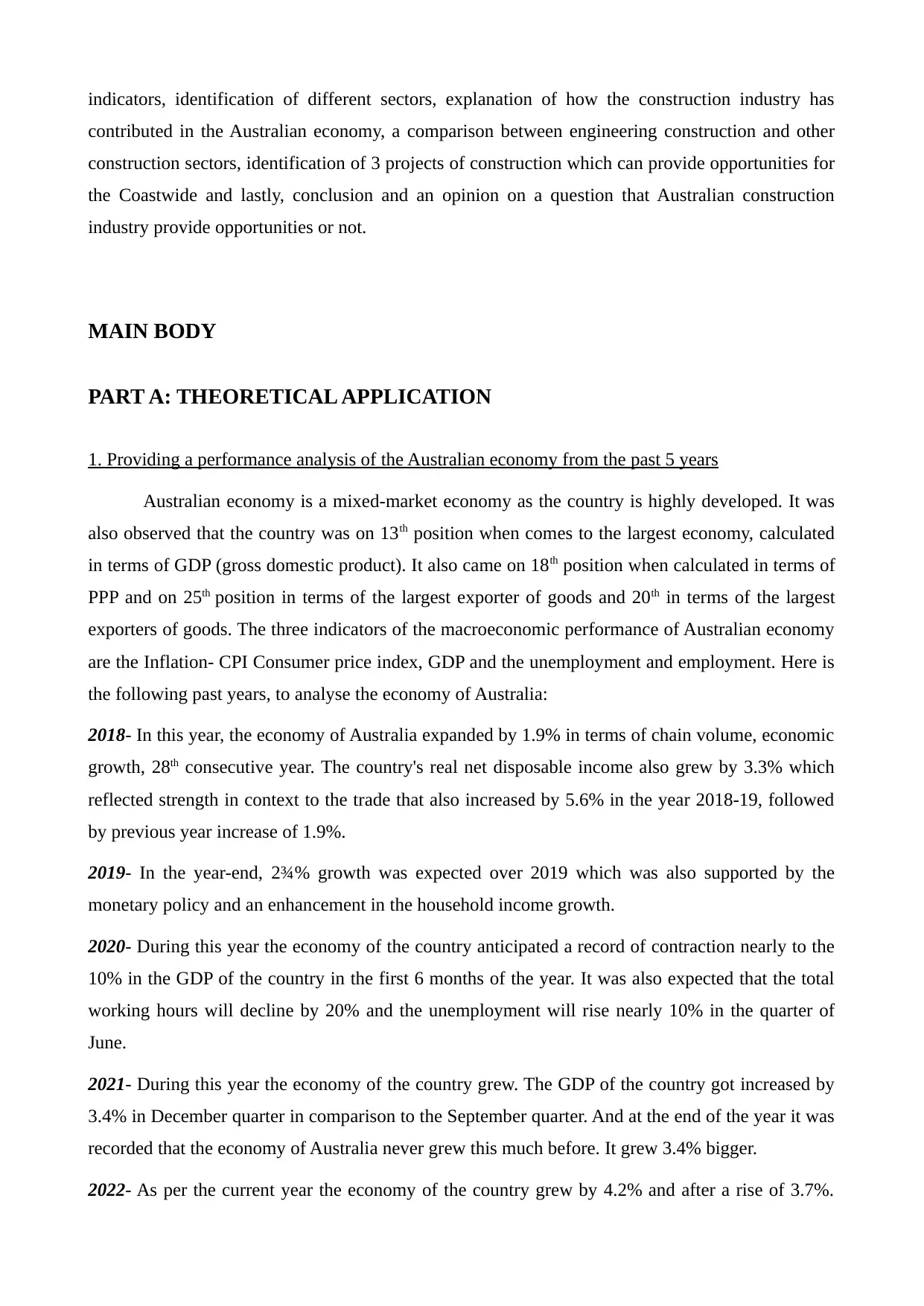
indicators, identification of different sectors, explanation of how the construction industry has
contributed in the Australian economy, a comparison between engineering construction and other
construction sectors, identification of 3 projects of construction which can provide opportunities for
the Coastwide and lastly, conclusion and an opinion on a question that Australian construction
industry provide opportunities or not.
MAIN BODY
PART A: THEORETICAL APPLICATION
1. Providing a performance analysis of the Australian economy from the past 5 years
Australian economy is a mixed-market economy as the country is highly developed. It was
also observed that the country was on 13th position when comes to the largest economy, calculated
in terms of GDP (gross domestic product). It also came on 18th position when calculated in terms of
PPP and on 25th position in terms of the largest exporter of goods and 20th in terms of the largest
exporters of goods. The three indicators of the macroeconomic performance of Australian economy
are the Inflation- CPI Consumer price index, GDP and the unemployment and employment. Here is
the following past years, to analyse the economy of Australia:
2018- In this year, the economy of Australia expanded by 1.9% in terms of chain volume, economic
growth, 28th consecutive year. The country's real net disposable income also grew by 3.3% which
reflected strength in context to the trade that also increased by 5.6% in the year 2018-19, followed
by previous year increase of 1.9%.
2019- In the year-end, 2¾% growth was expected over 2019 which was also supported by the
monetary policy and an enhancement in the household income growth.
2020- During this year the economy of the country anticipated a record of contraction nearly to the
10% in the GDP of the country in the first 6 months of the year. It was also expected that the total
working hours will decline by 20% and the unemployment will rise nearly 10% in the quarter of
June.
2021- During this year the economy of the country grew. The GDP of the country got increased by
3.4% in December quarter in comparison to the September quarter. And at the end of the year it was
recorded that the economy of Australia never grew this much before. It grew 3.4% bigger.
2022- As per the current year the economy of the country grew by 4.2% and after a rise of 3.7%.
contributed in the Australian economy, a comparison between engineering construction and other
construction sectors, identification of 3 projects of construction which can provide opportunities for
the Coastwide and lastly, conclusion and an opinion on a question that Australian construction
industry provide opportunities or not.
MAIN BODY
PART A: THEORETICAL APPLICATION
1. Providing a performance analysis of the Australian economy from the past 5 years
Australian economy is a mixed-market economy as the country is highly developed. It was
also observed that the country was on 13th position when comes to the largest economy, calculated
in terms of GDP (gross domestic product). It also came on 18th position when calculated in terms of
PPP and on 25th position in terms of the largest exporter of goods and 20th in terms of the largest
exporters of goods. The three indicators of the macroeconomic performance of Australian economy
are the Inflation- CPI Consumer price index, GDP and the unemployment and employment. Here is
the following past years, to analyse the economy of Australia:
2018- In this year, the economy of Australia expanded by 1.9% in terms of chain volume, economic
growth, 28th consecutive year. The country's real net disposable income also grew by 3.3% which
reflected strength in context to the trade that also increased by 5.6% in the year 2018-19, followed
by previous year increase of 1.9%.
2019- In the year-end, 2¾% growth was expected over 2019 which was also supported by the
monetary policy and an enhancement in the household income growth.
2020- During this year the economy of the country anticipated a record of contraction nearly to the
10% in the GDP of the country in the first 6 months of the year. It was also expected that the total
working hours will decline by 20% and the unemployment will rise nearly 10% in the quarter of
June.
2021- During this year the economy of the country grew. The GDP of the country got increased by
3.4% in December quarter in comparison to the September quarter. And at the end of the year it was
recorded that the economy of Australia never grew this much before. It grew 3.4% bigger.
2022- As per the current year the economy of the country grew by 4.2% and after a rise of 3.7%.
Secure Best Marks with AI Grader
Need help grading? Try our AI Grader for instant feedback on your assignments.
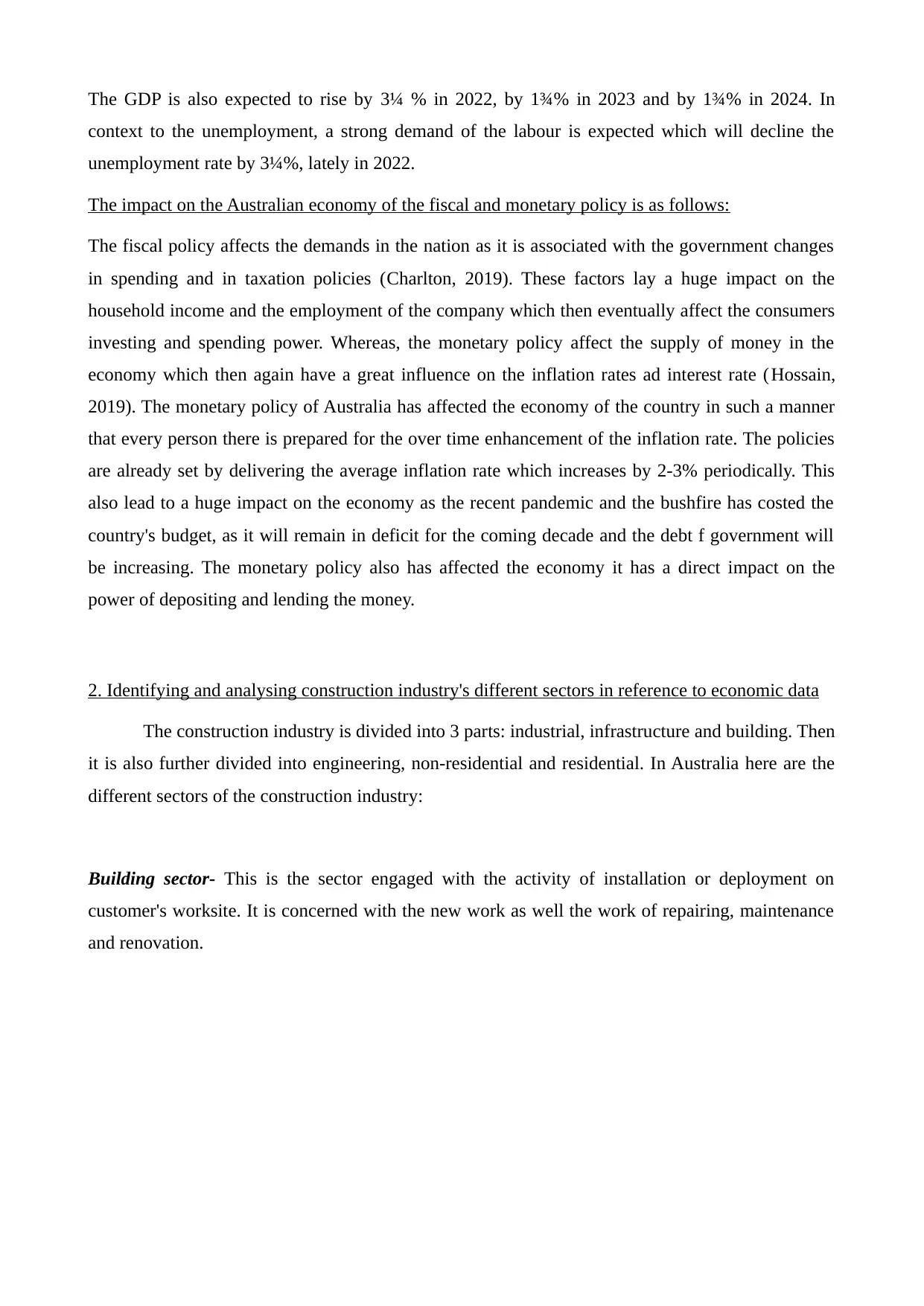
The GDP is also expected to rise by 3¼ % in 2022, by 1¾% in 2023 and by 1¾% in 2024. In
context to the unemployment, a strong demand of the labour is expected which will decline the
unemployment rate by 3¼%, lately in 2022.
The impact on the Australian economy of the fiscal and monetary policy is as follows:
The fiscal policy affects the demands in the nation as it is associated with the government changes
in spending and in taxation policies (Charlton, 2019). These factors lay a huge impact on the
household income and the employment of the company which then eventually affect the consumers
investing and spending power. Whereas, the monetary policy affect the supply of money in the
economy which then again have a great influence on the inflation rates ad interest rate (Hossain,
2019). The monetary policy of Australia has affected the economy of the country in such a manner
that every person there is prepared for the over time enhancement of the inflation rate. The policies
are already set by delivering the average inflation rate which increases by 2-3% periodically. This
also lead to a huge impact on the economy as the recent pandemic and the bushfire has costed the
country's budget, as it will remain in deficit for the coming decade and the debt f government will
be increasing. The monetary policy also has affected the economy it has a direct impact on the
power of depositing and lending the money.
2. Identifying and analysing construction industry's different sectors in reference to economic data
The construction industry is divided into 3 parts: industrial, infrastructure and building. Then
it is also further divided into engineering, non-residential and residential. In Australia here are the
different sectors of the construction industry:
Building sector- This is the sector engaged with the activity of installation or deployment on
customer's worksite. It is concerned with the new work as well the work of repairing, maintenance
and renovation.
context to the unemployment, a strong demand of the labour is expected which will decline the
unemployment rate by 3¼%, lately in 2022.
The impact on the Australian economy of the fiscal and monetary policy is as follows:
The fiscal policy affects the demands in the nation as it is associated with the government changes
in spending and in taxation policies (Charlton, 2019). These factors lay a huge impact on the
household income and the employment of the company which then eventually affect the consumers
investing and spending power. Whereas, the monetary policy affect the supply of money in the
economy which then again have a great influence on the inflation rates ad interest rate (Hossain,
2019). The monetary policy of Australia has affected the economy of the country in such a manner
that every person there is prepared for the over time enhancement of the inflation rate. The policies
are already set by delivering the average inflation rate which increases by 2-3% periodically. This
also lead to a huge impact on the economy as the recent pandemic and the bushfire has costed the
country's budget, as it will remain in deficit for the coming decade and the debt f government will
be increasing. The monetary policy also has affected the economy it has a direct impact on the
power of depositing and lending the money.
2. Identifying and analysing construction industry's different sectors in reference to economic data
The construction industry is divided into 3 parts: industrial, infrastructure and building. Then
it is also further divided into engineering, non-residential and residential. In Australia here are the
different sectors of the construction industry:
Building sector- This is the sector engaged with the activity of installation or deployment on
customer's worksite. It is concerned with the new work as well the work of repairing, maintenance
and renovation.
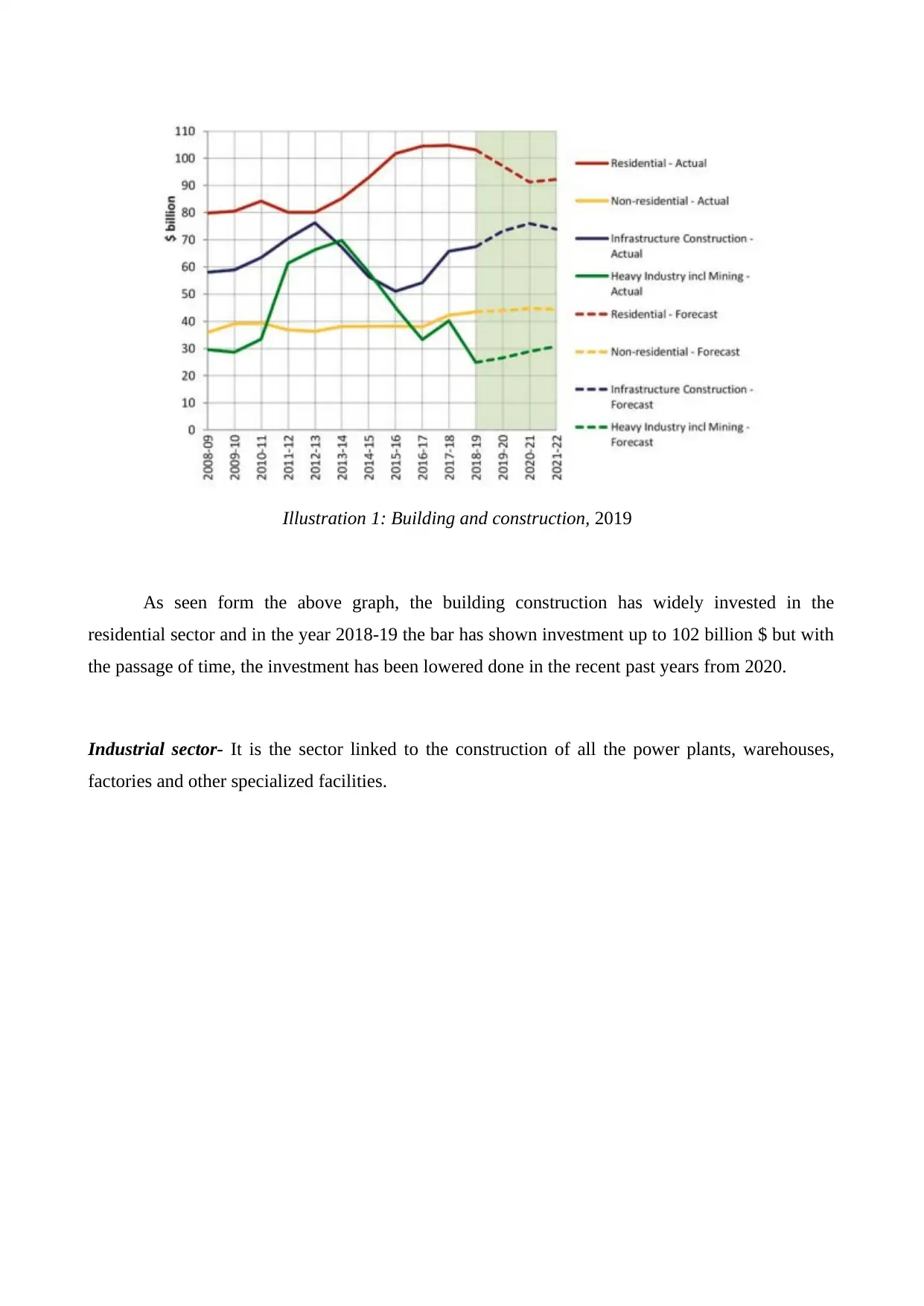
As seen form the above graph, the building construction has widely invested in the
residential sector and in the year 2018-19 the bar has shown investment up to 102 billion $ but with
the passage of time, the investment has been lowered done in the recent past years from 2020.
Industrial sector- It is the sector linked to the construction of all the power plants, warehouses,
factories and other specialized facilities.
Illustration 1: Building and construction, 2019
residential sector and in the year 2018-19 the bar has shown investment up to 102 billion $ but with
the passage of time, the investment has been lowered done in the recent past years from 2020.
Industrial sector- It is the sector linked to the construction of all the power plants, warehouses,
factories and other specialized facilities.
Illustration 1: Building and construction, 2019
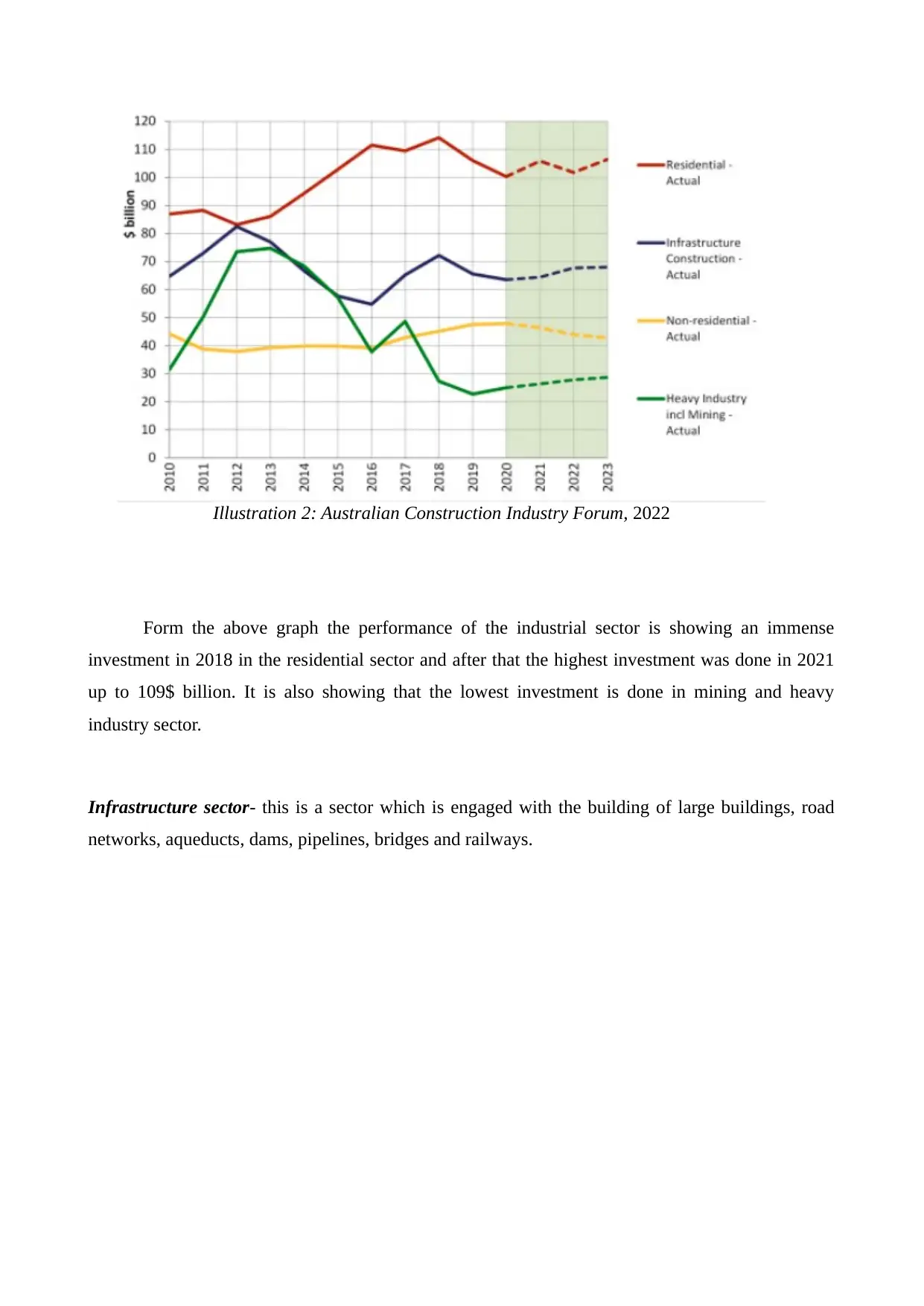
Form the above graph the performance of the industrial sector is showing an immense
investment in 2018 in the residential sector and after that the highest investment was done in 2021
up to 109$ billion. It is also showing that the lowest investment is done in mining and heavy
industry sector.
Infrastructure sector- this is a sector which is engaged with the building of large buildings, road
networks, aqueducts, dams, pipelines, bridges and railways.
Illustration 2: Australian Construction Industry Forum, 2022
investment in 2018 in the residential sector and after that the highest investment was done in 2021
up to 109$ billion. It is also showing that the lowest investment is done in mining and heavy
industry sector.
Infrastructure sector- this is a sector which is engaged with the building of large buildings, road
networks, aqueducts, dams, pipelines, bridges and railways.
Illustration 2: Australian Construction Industry Forum, 2022
Paraphrase This Document
Need a fresh take? Get an instant paraphrase of this document with our AI Paraphraser
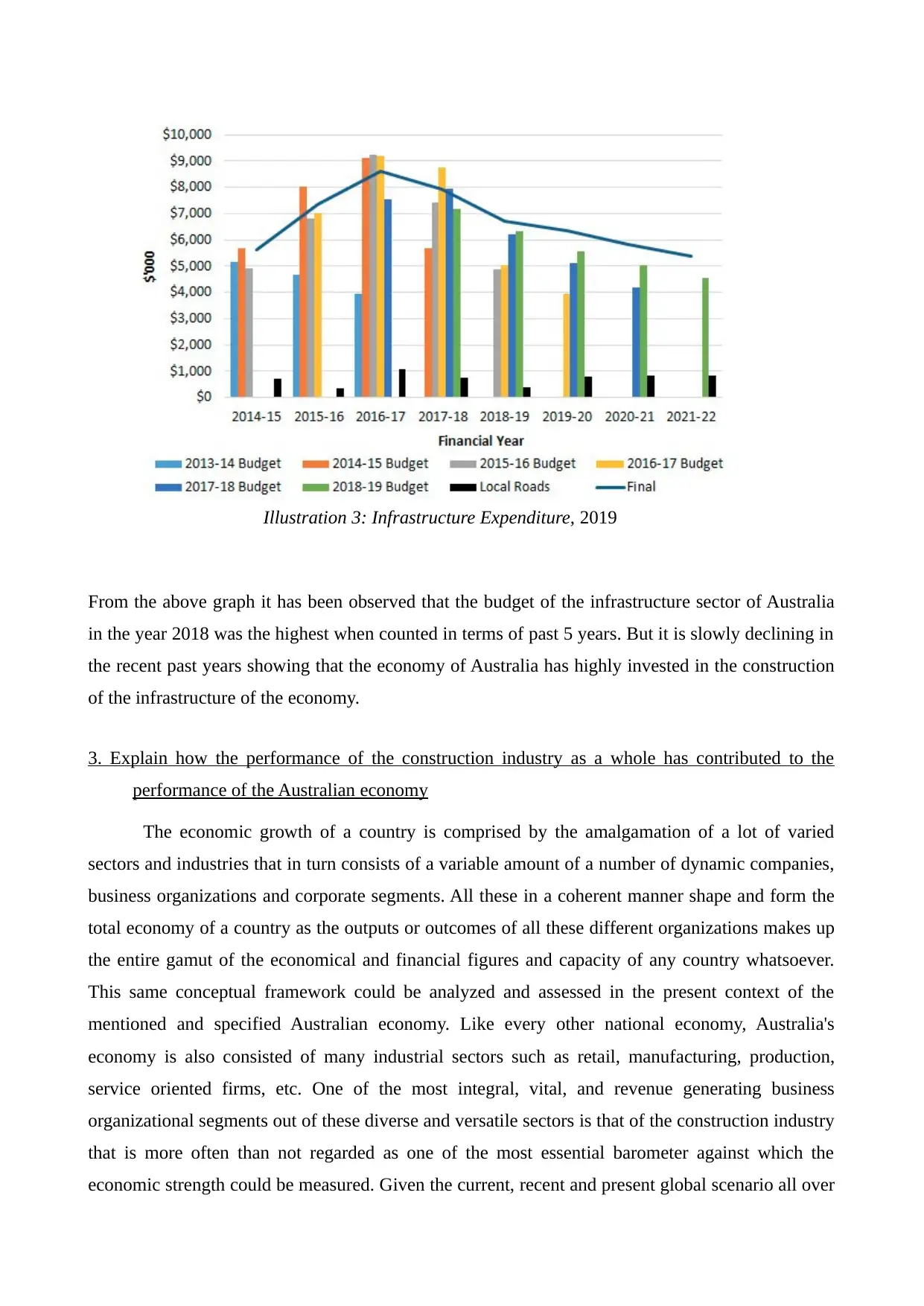
From the above graph it has been observed that the budget of the infrastructure sector of Australia
in the year 2018 was the highest when counted in terms of past 5 years. But it is slowly declining in
the recent past years showing that the economy of Australia has highly invested in the construction
of the infrastructure of the economy.
3. Explain how the performance of the construction industry as a whole has contributed to the
performance of the Australian economy
The economic growth of a country is comprised by the amalgamation of a lot of varied
sectors and industries that in turn consists of a variable amount of a number of dynamic companies,
business organizations and corporate segments. All these in a coherent manner shape and form the
total economy of a country as the outputs or outcomes of all these different organizations makes up
the entire gamut of the economical and financial figures and capacity of any country whatsoever.
This same conceptual framework could be analyzed and assessed in the present context of the
mentioned and specified Australian economy. Like every other national economy, Australia's
economy is also consisted of many industrial sectors such as retail, manufacturing, production,
service oriented firms, etc. One of the most integral, vital, and revenue generating business
organizational segments out of these diverse and versatile sectors is that of the construction industry
that is more often than not regarded as one of the most essential barometer against which the
economic strength could be measured. Given the current, recent and present global scenario all over
Illustration 3: Infrastructure Expenditure, 2019
in the year 2018 was the highest when counted in terms of past 5 years. But it is slowly declining in
the recent past years showing that the economy of Australia has highly invested in the construction
of the infrastructure of the economy.
3. Explain how the performance of the construction industry as a whole has contributed to the
performance of the Australian economy
The economic growth of a country is comprised by the amalgamation of a lot of varied
sectors and industries that in turn consists of a variable amount of a number of dynamic companies,
business organizations and corporate segments. All these in a coherent manner shape and form the
total economy of a country as the outputs or outcomes of all these different organizations makes up
the entire gamut of the economical and financial figures and capacity of any country whatsoever.
This same conceptual framework could be analyzed and assessed in the present context of the
mentioned and specified Australian economy. Like every other national economy, Australia's
economy is also consisted of many industrial sectors such as retail, manufacturing, production,
service oriented firms, etc. One of the most integral, vital, and revenue generating business
organizational segments out of these diverse and versatile sectors is that of the construction industry
that is more often than not regarded as one of the most essential barometer against which the
economic strength could be measured. Given the current, recent and present global scenario all over
Illustration 3: Infrastructure Expenditure, 2019
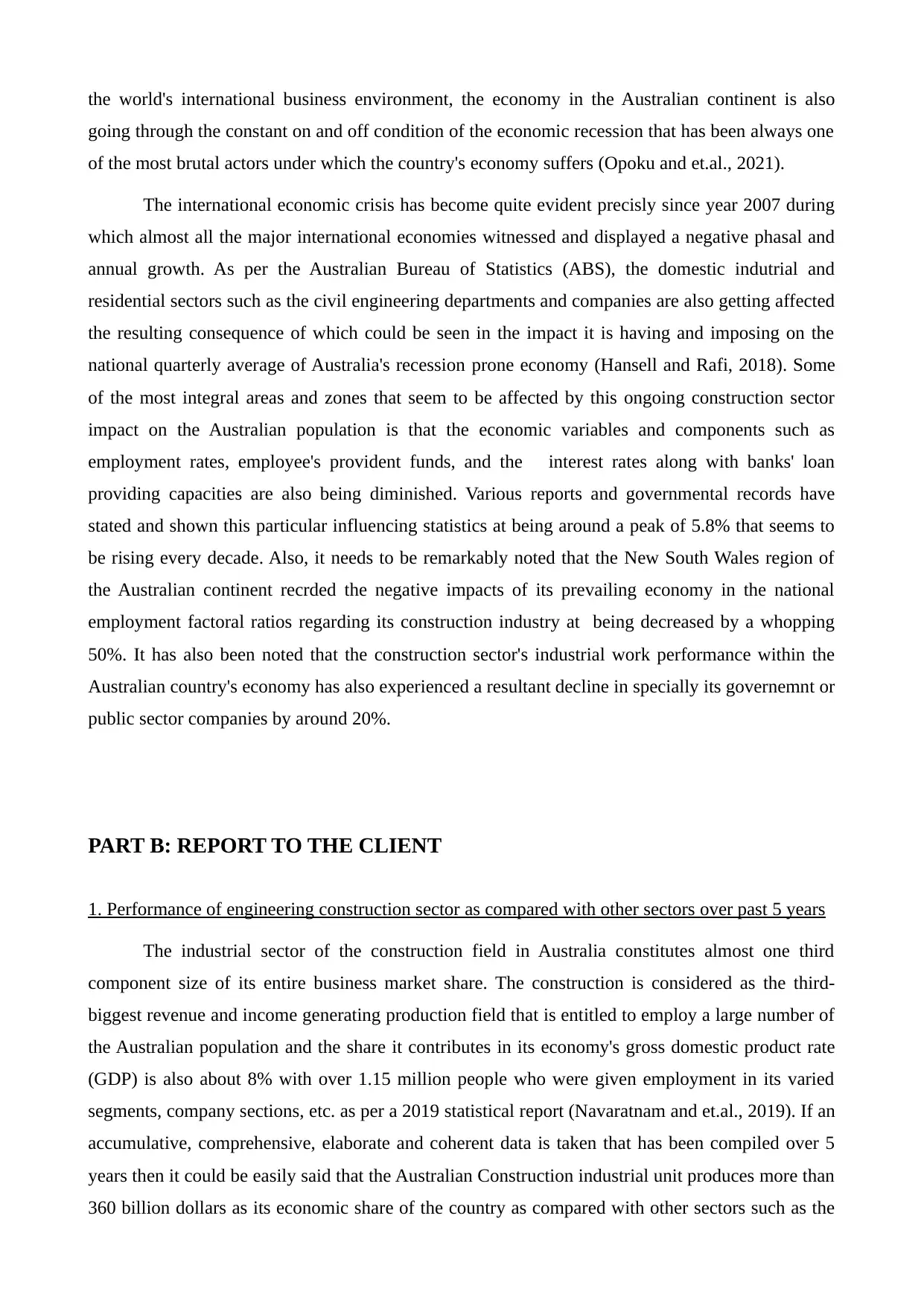
the world's international business environment, the economy in the Australian continent is also
going through the constant on and off condition of the economic recession that has been always one
of the most brutal actors under which the country's economy suffers (Opoku and et.al., 2021).
The international economic crisis has become quite evident precisly since year 2007 during
which almost all the major international economies witnessed and displayed a negative phasal and
annual growth. As per the Australian Bureau of Statistics (ABS), the domestic indutrial and
residential sectors such as the civil engineering departments and companies are also getting affected
the resulting consequence of which could be seen in the impact it is having and imposing on the
national quarterly average of Australia's recession prone economy (Hansell and Rafi, 2018). Some
of the most integral areas and zones that seem to be affected by this ongoing construction sector
impact on the Australian population is that the economic variables and components such as
employment rates, employee's provident funds, and the interest rates along with banks' loan
providing capacities are also being diminished. Various reports and governmental records have
stated and shown this particular influencing statistics at being around a peak of 5.8% that seems to
be rising every decade. Also, it needs to be remarkably noted that the New South Wales region of
the Australian continent recrded the negative impacts of its prevailing economy in the national
employment factoral ratios regarding its construction industry at being decreased by a whopping
50%. It has also been noted that the construction sector's industrial work performance within the
Australian country's economy has also experienced a resultant decline in specially its governemnt or
public sector companies by around 20%.
PART B: REPORT TO THE CLIENT
1. Performance of engineering construction sector as compared with other sectors over past 5 years
The industrial sector of the construction field in Australia constitutes almost one third
component size of its entire business market share. The construction is considered as the third-
biggest revenue and income generating production field that is entitled to employ a large number of
the Australian population and the share it contributes in its economy's gross domestic product rate
(GDP) is also about 8% with over 1.15 million people who were given employment in its varied
segments, company sections, etc. as per a 2019 statistical report (Navaratnam and et.al., 2019). If an
accumulative, comprehensive, elaborate and coherent data is taken that has been compiled over 5
years then it could be easily said that the Australian Construction industrial unit produces more than
360 billion dollars as its economic share of the country as compared with other sectors such as the
going through the constant on and off condition of the economic recession that has been always one
of the most brutal actors under which the country's economy suffers (Opoku and et.al., 2021).
The international economic crisis has become quite evident precisly since year 2007 during
which almost all the major international economies witnessed and displayed a negative phasal and
annual growth. As per the Australian Bureau of Statistics (ABS), the domestic indutrial and
residential sectors such as the civil engineering departments and companies are also getting affected
the resulting consequence of which could be seen in the impact it is having and imposing on the
national quarterly average of Australia's recession prone economy (Hansell and Rafi, 2018). Some
of the most integral areas and zones that seem to be affected by this ongoing construction sector
impact on the Australian population is that the economic variables and components such as
employment rates, employee's provident funds, and the interest rates along with banks' loan
providing capacities are also being diminished. Various reports and governmental records have
stated and shown this particular influencing statistics at being around a peak of 5.8% that seems to
be rising every decade. Also, it needs to be remarkably noted that the New South Wales region of
the Australian continent recrded the negative impacts of its prevailing economy in the national
employment factoral ratios regarding its construction industry at being decreased by a whopping
50%. It has also been noted that the construction sector's industrial work performance within the
Australian country's economy has also experienced a resultant decline in specially its governemnt or
public sector companies by around 20%.
PART B: REPORT TO THE CLIENT
1. Performance of engineering construction sector as compared with other sectors over past 5 years
The industrial sector of the construction field in Australia constitutes almost one third
component size of its entire business market share. The construction is considered as the third-
biggest revenue and income generating production field that is entitled to employ a large number of
the Australian population and the share it contributes in its economy's gross domestic product rate
(GDP) is also about 8% with over 1.15 million people who were given employment in its varied
segments, company sections, etc. as per a 2019 statistical report (Navaratnam and et.al., 2019). If an
accumulative, comprehensive, elaborate and coherent data is taken that has been compiled over 5
years then it could be easily said that the Australian Construction industrial unit produces more than
360 billion dollars as its economic share of the country as compared with other sectors such as the
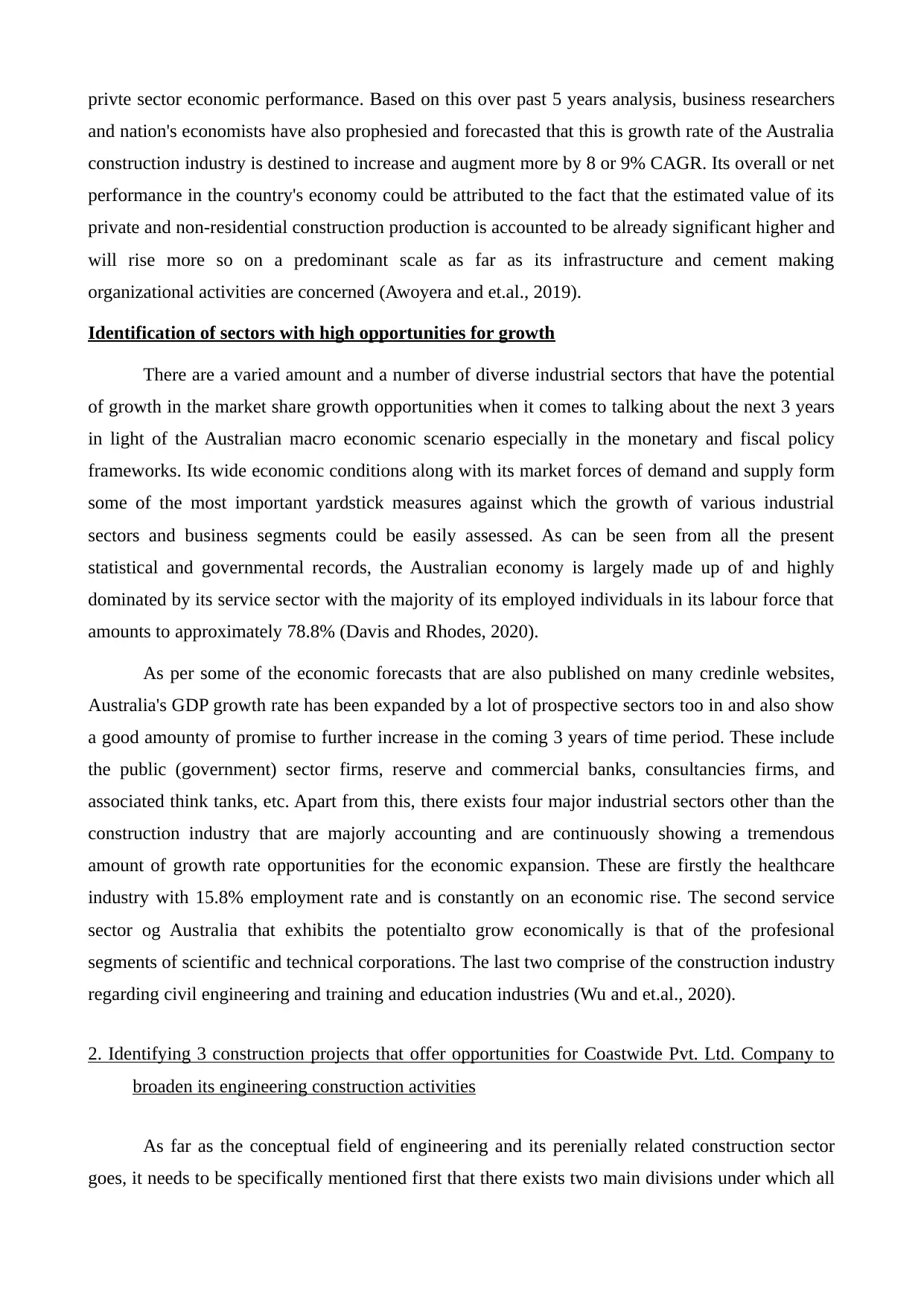
privte sector economic performance. Based on this over past 5 years analysis, business researchers
and nation's economists have also prophesied and forecasted that this is growth rate of the Australia
construction industry is destined to increase and augment more by 8 or 9% CAGR. Its overall or net
performance in the country's economy could be attributed to the fact that the estimated value of its
private and non-residential construction production is accounted to be already significant higher and
will rise more so on a predominant scale as far as its infrastructure and cement making
organizational activities are concerned (Awoyera and et.al., 2019).
Identification of sectors with high opportunities for growth
There are a varied amount and a number of diverse industrial sectors that have the potential
of growth in the market share growth opportunities when it comes to talking about the next 3 years
in light of the Australian macro economic scenario especially in the monetary and fiscal policy
frameworks. Its wide economic conditions along with its market forces of demand and supply form
some of the most important yardstick measures against which the growth of various industrial
sectors and business segments could be easily assessed. As can be seen from all the present
statistical and governmental records, the Australian economy is largely made up of and highly
dominated by its service sector with the majority of its employed individuals in its labour force that
amounts to approximately 78.8% (Davis and Rhodes, 2020).
As per some of the economic forecasts that are also published on many credinle websites,
Australia's GDP growth rate has been expanded by a lot of prospective sectors too in and also show
a good amounty of promise to further increase in the coming 3 years of time period. These include
the public (government) sector firms, reserve and commercial banks, consultancies firms, and
associated think tanks, etc. Apart from this, there exists four major industrial sectors other than the
construction industry that are majorly accounting and are continuously showing a tremendous
amount of growth rate opportunities for the economic expansion. These are firstly the healthcare
industry with 15.8% employment rate and is constantly on an economic rise. The second service
sector og Australia that exhibits the potentialto grow economically is that of the profesional
segments of scientific and technical corporations. The last two comprise of the construction industry
regarding civil engineering and training and education industries (Wu and et.al., 2020).
2. Identifying 3 construction projects that offer opportunities for Coastwide Pvt. Ltd. Company to
broaden its engineering construction activities
As far as the conceptual field of engineering and its perenially related construction sector
goes, it needs to be specifically mentioned first that there exists two main divisions under which all
and nation's economists have also prophesied and forecasted that this is growth rate of the Australia
construction industry is destined to increase and augment more by 8 or 9% CAGR. Its overall or net
performance in the country's economy could be attributed to the fact that the estimated value of its
private and non-residential construction production is accounted to be already significant higher and
will rise more so on a predominant scale as far as its infrastructure and cement making
organizational activities are concerned (Awoyera and et.al., 2019).
Identification of sectors with high opportunities for growth
There are a varied amount and a number of diverse industrial sectors that have the potential
of growth in the market share growth opportunities when it comes to talking about the next 3 years
in light of the Australian macro economic scenario especially in the monetary and fiscal policy
frameworks. Its wide economic conditions along with its market forces of demand and supply form
some of the most important yardstick measures against which the growth of various industrial
sectors and business segments could be easily assessed. As can be seen from all the present
statistical and governmental records, the Australian economy is largely made up of and highly
dominated by its service sector with the majority of its employed individuals in its labour force that
amounts to approximately 78.8% (Davis and Rhodes, 2020).
As per some of the economic forecasts that are also published on many credinle websites,
Australia's GDP growth rate has been expanded by a lot of prospective sectors too in and also show
a good amounty of promise to further increase in the coming 3 years of time period. These include
the public (government) sector firms, reserve and commercial banks, consultancies firms, and
associated think tanks, etc. Apart from this, there exists four major industrial sectors other than the
construction industry that are majorly accounting and are continuously showing a tremendous
amount of growth rate opportunities for the economic expansion. These are firstly the healthcare
industry with 15.8% employment rate and is constantly on an economic rise. The second service
sector og Australia that exhibits the potentialto grow economically is that of the profesional
segments of scientific and technical corporations. The last two comprise of the construction industry
regarding civil engineering and training and education industries (Wu and et.al., 2020).
2. Identifying 3 construction projects that offer opportunities for Coastwide Pvt. Ltd. Company to
broaden its engineering construction activities
As far as the conceptual field of engineering and its perenially related construction sector
goes, it needs to be specifically mentioned first that there exists two main divisions under which all
Secure Best Marks with AI Grader
Need help grading? Try our AI Grader for instant feedback on your assignments.
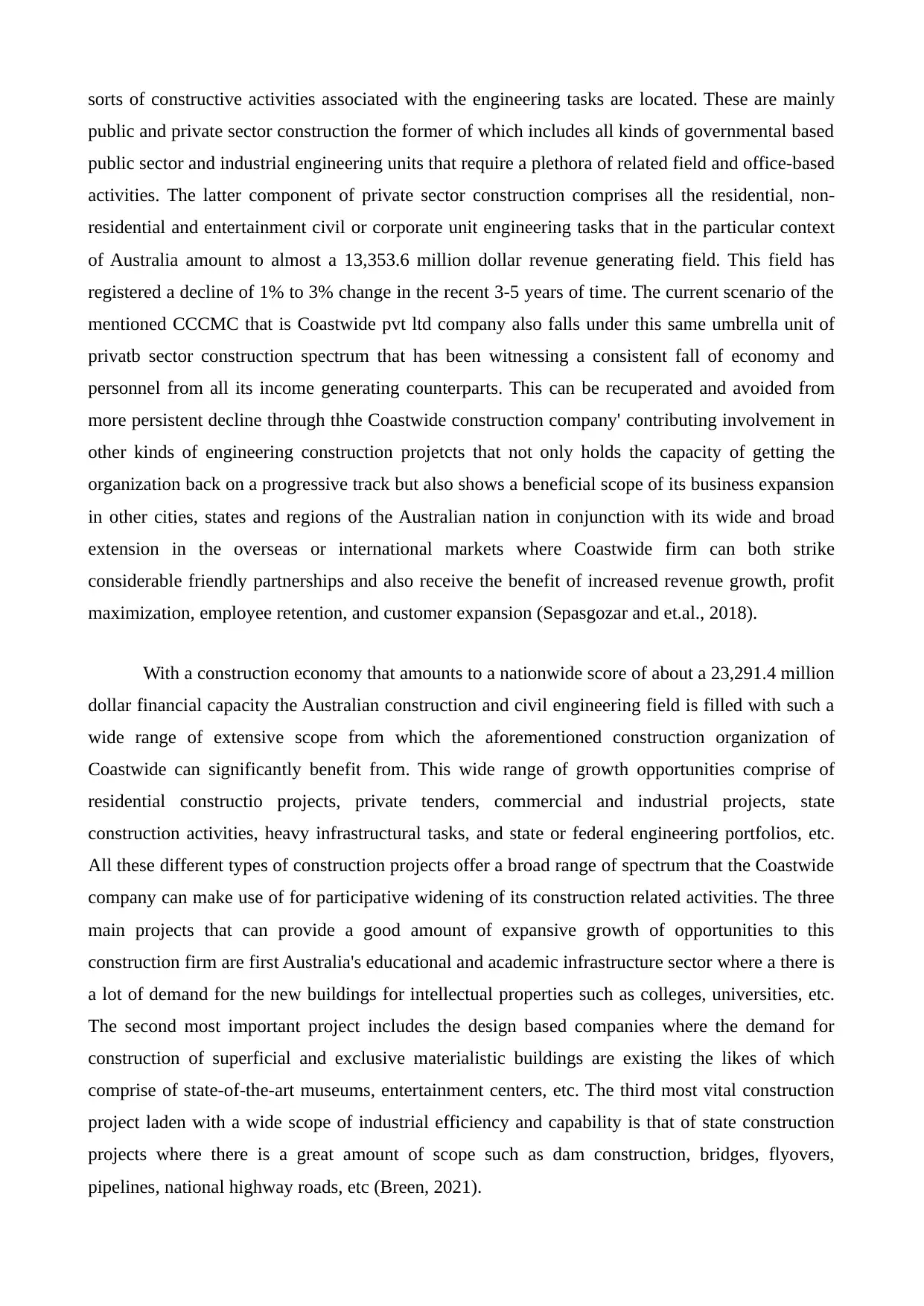
sorts of constructive activities associated with the engineering tasks are located. These are mainly
public and private sector construction the former of which includes all kinds of governmental based
public sector and industrial engineering units that require a plethora of related field and office-based
activities. The latter component of private sector construction comprises all the residential, non-
residential and entertainment civil or corporate unit engineering tasks that in the particular context
of Australia amount to almost a 13,353.6 million dollar revenue generating field. This field has
registered a decline of 1% to 3% change in the recent 3-5 years of time. The current scenario of the
mentioned CCCMC that is Coastwide pvt ltd company also falls under this same umbrella unit of
privatb sector construction spectrum that has been witnessing a consistent fall of economy and
personnel from all its income generating counterparts. This can be recuperated and avoided from
more persistent decline through thhe Coastwide construction company' contributing involvement in
other kinds of engineering construction projetcts that not only holds the capacity of getting the
organization back on a progressive track but also shows a beneficial scope of its business expansion
in other cities, states and regions of the Australian nation in conjunction with its wide and broad
extension in the overseas or international markets where Coastwide firm can both strike
considerable friendly partnerships and also receive the benefit of increased revenue growth, profit
maximization, employee retention, and customer expansion (Sepasgozar and et.al., 2018).
With a construction economy that amounts to a nationwide score of about a 23,291.4 million
dollar financial capacity the Australian construction and civil engineering field is filled with such a
wide range of extensive scope from which the aforementioned construction organization of
Coastwide can significantly benefit from. This wide range of growth opportunities comprise of
residential constructio projects, private tenders, commercial and industrial projects, state
construction activities, heavy infrastructural tasks, and state or federal engineering portfolios, etc.
All these different types of construction projects offer a broad range of spectrum that the Coastwide
company can make use of for participative widening of its construction related activities. The three
main projects that can provide a good amount of expansive growth of opportunities to this
construction firm are first Australia's educational and academic infrastructure sector where a there is
a lot of demand for the new buildings for intellectual properties such as colleges, universities, etc.
The second most important project includes the design based companies where the demand for
construction of superficial and exclusive materialistic buildings are existing the likes of which
comprise of state-of-the-art museums, entertainment centers, etc. The third most vital construction
project laden with a wide scope of industrial efficiency and capability is that of state construction
projects where there is a great amount of scope such as dam construction, bridges, flyovers,
pipelines, national highway roads, etc (Breen, 2021).
public and private sector construction the former of which includes all kinds of governmental based
public sector and industrial engineering units that require a plethora of related field and office-based
activities. The latter component of private sector construction comprises all the residential, non-
residential and entertainment civil or corporate unit engineering tasks that in the particular context
of Australia amount to almost a 13,353.6 million dollar revenue generating field. This field has
registered a decline of 1% to 3% change in the recent 3-5 years of time. The current scenario of the
mentioned CCCMC that is Coastwide pvt ltd company also falls under this same umbrella unit of
privatb sector construction spectrum that has been witnessing a consistent fall of economy and
personnel from all its income generating counterparts. This can be recuperated and avoided from
more persistent decline through thhe Coastwide construction company' contributing involvement in
other kinds of engineering construction projetcts that not only holds the capacity of getting the
organization back on a progressive track but also shows a beneficial scope of its business expansion
in other cities, states and regions of the Australian nation in conjunction with its wide and broad
extension in the overseas or international markets where Coastwide firm can both strike
considerable friendly partnerships and also receive the benefit of increased revenue growth, profit
maximization, employee retention, and customer expansion (Sepasgozar and et.al., 2018).
With a construction economy that amounts to a nationwide score of about a 23,291.4 million
dollar financial capacity the Australian construction and civil engineering field is filled with such a
wide range of extensive scope from which the aforementioned construction organization of
Coastwide can significantly benefit from. This wide range of growth opportunities comprise of
residential constructio projects, private tenders, commercial and industrial projects, state
construction activities, heavy infrastructural tasks, and state or federal engineering portfolios, etc.
All these different types of construction projects offer a broad range of spectrum that the Coastwide
company can make use of for participative widening of its construction related activities. The three
main projects that can provide a good amount of expansive growth of opportunities to this
construction firm are first Australia's educational and academic infrastructure sector where a there is
a lot of demand for the new buildings for intellectual properties such as colleges, universities, etc.
The second most important project includes the design based companies where the demand for
construction of superficial and exclusive materialistic buildings are existing the likes of which
comprise of state-of-the-art museums, entertainment centers, etc. The third most vital construction
project laden with a wide scope of industrial efficiency and capability is that of state construction
projects where there is a great amount of scope such as dam construction, bridges, flyovers,
pipelines, national highway roads, etc (Breen, 2021).
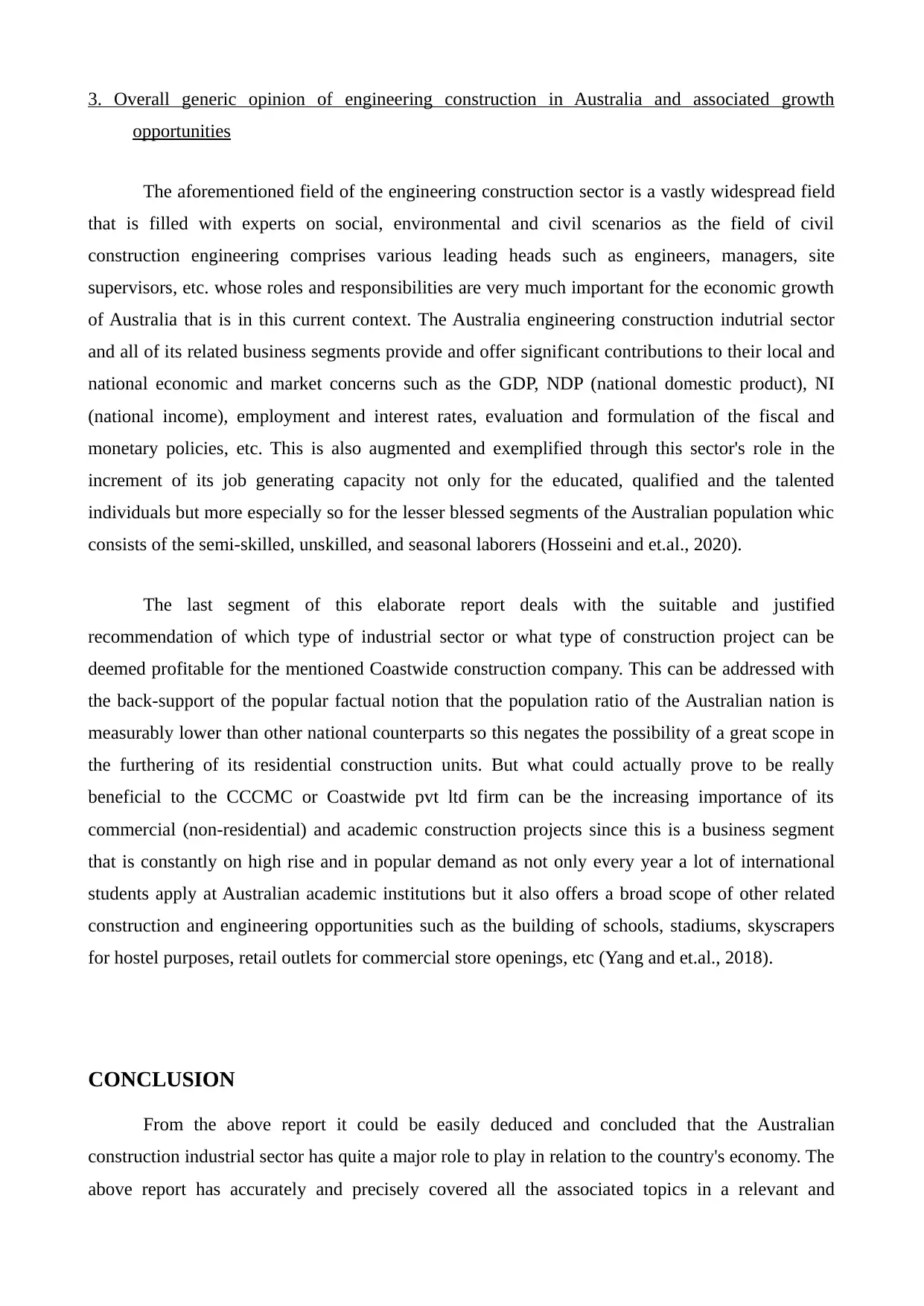
3. Overall generic opinion of engineering construction in Australia and associated growth
opportunities
The aforementioned field of the engineering construction sector is a vastly widespread field
that is filled with experts on social, environmental and civil scenarios as the field of civil
construction engineering comprises various leading heads such as engineers, managers, site
supervisors, etc. whose roles and responsibilities are very much important for the economic growth
of Australia that is in this current context. The Australia engineering construction indutrial sector
and all of its related business segments provide and offer significant contributions to their local and
national economic and market concerns such as the GDP, NDP (national domestic product), NI
(national income), employment and interest rates, evaluation and formulation of the fiscal and
monetary policies, etc. This is also augmented and exemplified through this sector's role in the
increment of its job generating capacity not only for the educated, qualified and the talented
individuals but more especially so for the lesser blessed segments of the Australian population whic
consists of the semi-skilled, unskilled, and seasonal laborers (Hosseini and et.al., 2020).
The last segment of this elaborate report deals with the suitable and justified
recommendation of which type of industrial sector or what type of construction project can be
deemed profitable for the mentioned Coastwide construction company. This can be addressed with
the back-support of the popular factual notion that the population ratio of the Australian nation is
measurably lower than other national counterparts so this negates the possibility of a great scope in
the furthering of its residential construction units. But what could actually prove to be really
beneficial to the CCCMC or Coastwide pvt ltd firm can be the increasing importance of its
commercial (non-residential) and academic construction projects since this is a business segment
that is constantly on high rise and in popular demand as not only every year a lot of international
students apply at Australian academic institutions but it also offers a broad scope of other related
construction and engineering opportunities such as the building of schools, stadiums, skyscrapers
for hostel purposes, retail outlets for commercial store openings, etc (Yang and et.al., 2018).
CONCLUSION
From the above report it could be easily deduced and concluded that the Australian
construction industrial sector has quite a major role to play in relation to the country's economy. The
above report has accurately and precisely covered all the associated topics in a relevant and
opportunities
The aforementioned field of the engineering construction sector is a vastly widespread field
that is filled with experts on social, environmental and civil scenarios as the field of civil
construction engineering comprises various leading heads such as engineers, managers, site
supervisors, etc. whose roles and responsibilities are very much important for the economic growth
of Australia that is in this current context. The Australia engineering construction indutrial sector
and all of its related business segments provide and offer significant contributions to their local and
national economic and market concerns such as the GDP, NDP (national domestic product), NI
(national income), employment and interest rates, evaluation and formulation of the fiscal and
monetary policies, etc. This is also augmented and exemplified through this sector's role in the
increment of its job generating capacity not only for the educated, qualified and the talented
individuals but more especially so for the lesser blessed segments of the Australian population whic
consists of the semi-skilled, unskilled, and seasonal laborers (Hosseini and et.al., 2020).
The last segment of this elaborate report deals with the suitable and justified
recommendation of which type of industrial sector or what type of construction project can be
deemed profitable for the mentioned Coastwide construction company. This can be addressed with
the back-support of the popular factual notion that the population ratio of the Australian nation is
measurably lower than other national counterparts so this negates the possibility of a great scope in
the furthering of its residential construction units. But what could actually prove to be really
beneficial to the CCCMC or Coastwide pvt ltd firm can be the increasing importance of its
commercial (non-residential) and academic construction projects since this is a business segment
that is constantly on high rise and in popular demand as not only every year a lot of international
students apply at Australian academic institutions but it also offers a broad scope of other related
construction and engineering opportunities such as the building of schools, stadiums, skyscrapers
for hostel purposes, retail outlets for commercial store openings, etc (Yang and et.al., 2018).
CONCLUSION
From the above report it could be easily deduced and concluded that the Australian
construction industrial sector has quite a major role to play in relation to the country's economy. The
above report has accurately and precisely covered all the associated topics in a relevant and
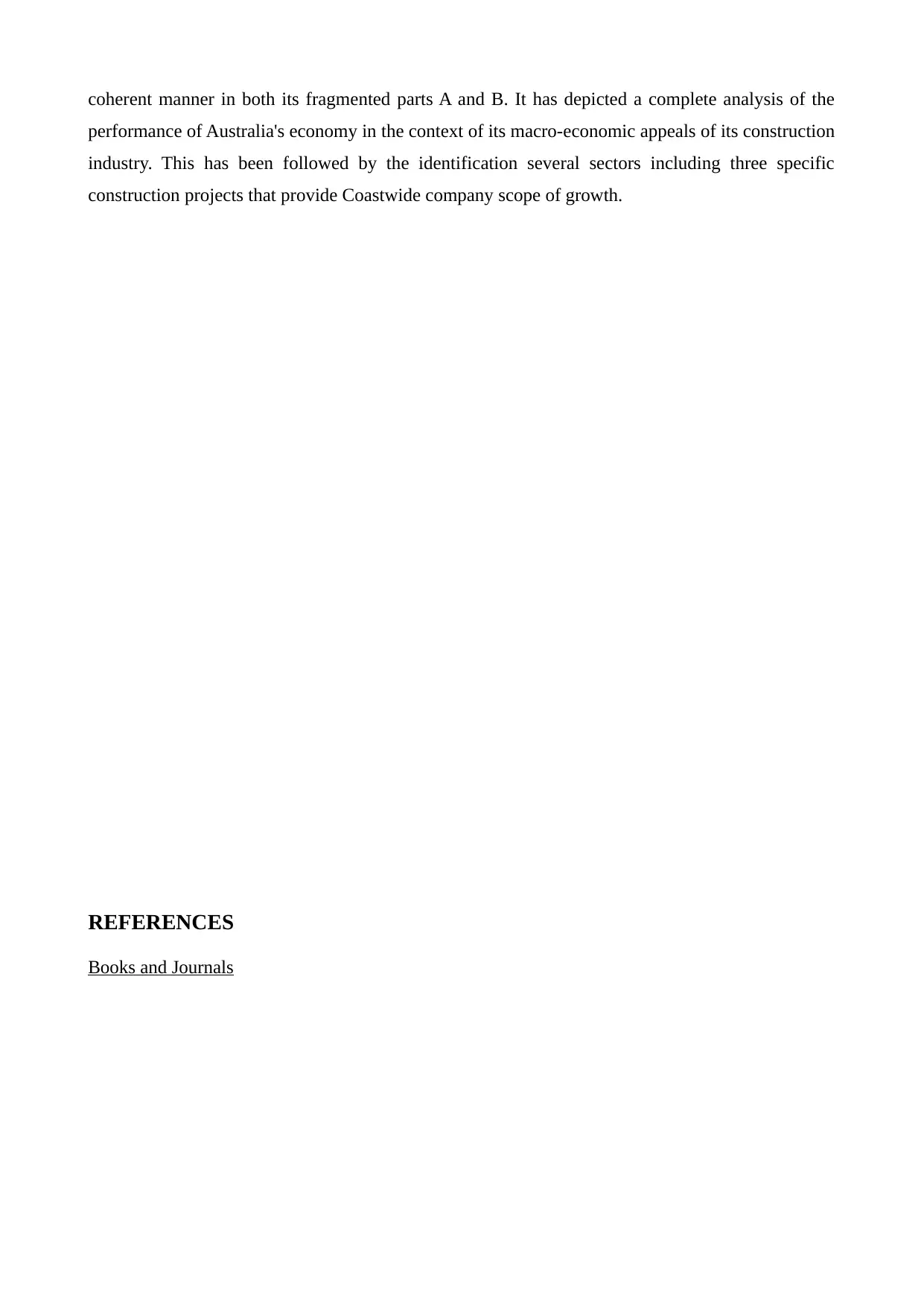
coherent manner in both its fragmented parts A and B. It has depicted a complete analysis of the
performance of Australia's economy in the context of its macro-economic appeals of its construction
industry. This has been followed by the identification several sectors including three specific
construction projects that provide Coastwide company scope of growth.
REFERENCES
Books and Journals
performance of Australia's economy in the context of its macro-economic appeals of its construction
industry. This has been followed by the identification several sectors including three specific
construction projects that provide Coastwide company scope of growth.
REFERENCES
Books and Journals
Paraphrase This Document
Need a fresh take? Get an instant paraphrase of this document with our AI Paraphraser
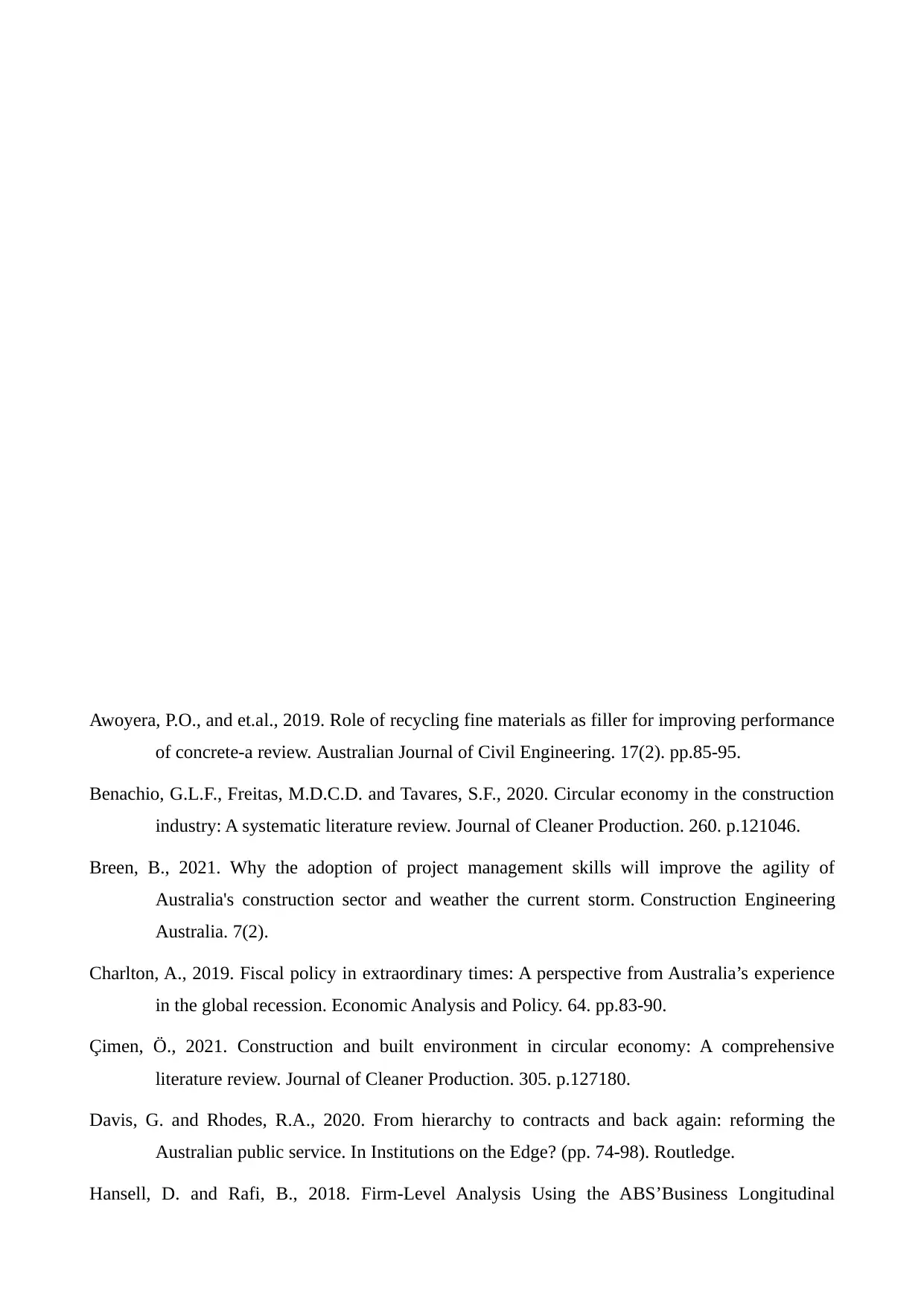
Awoyera, P.O., and et.al., 2019. Role of recycling fine materials as filler for improving performance
of concrete-a review. Australian Journal of Civil Engineering. 17(2). pp.85-95.
Benachio, G.L.F., Freitas, M.D.C.D. and Tavares, S.F., 2020. Circular economy in the construction
industry: A systematic literature review. Journal of Cleaner Production. 260. p.121046.
Breen, B., 2021. Why the adoption of project management skills will improve the agility of
Australia's construction sector and weather the current storm. Construction Engineering
Australia. 7(2).
Charlton, A., 2019. Fiscal policy in extraordinary times: A perspective from Australia’s experience
in the global recession. Economic Analysis and Policy. 64. pp.83-90.
Çimen, Ö., 2021. Construction and built environment in circular economy: A comprehensive
literature review. Journal of Cleaner Production. 305. p.127180.
Davis, G. and Rhodes, R.A., 2020. From hierarchy to contracts and back again: reforming the
Australian public service. In Institutions on the Edge? (pp. 74-98). Routledge.
Hansell, D. and Rafi, B., 2018. Firm‐Level Analysis Using the ABS’Business Longitudinal
of concrete-a review. Australian Journal of Civil Engineering. 17(2). pp.85-95.
Benachio, G.L.F., Freitas, M.D.C.D. and Tavares, S.F., 2020. Circular economy in the construction
industry: A systematic literature review. Journal of Cleaner Production. 260. p.121046.
Breen, B., 2021. Why the adoption of project management skills will improve the agility of
Australia's construction sector and weather the current storm. Construction Engineering
Australia. 7(2).
Charlton, A., 2019. Fiscal policy in extraordinary times: A perspective from Australia’s experience
in the global recession. Economic Analysis and Policy. 64. pp.83-90.
Çimen, Ö., 2021. Construction and built environment in circular economy: A comprehensive
literature review. Journal of Cleaner Production. 305. p.127180.
Davis, G. and Rhodes, R.A., 2020. From hierarchy to contracts and back again: reforming the
Australian public service. In Institutions on the Edge? (pp. 74-98). Routledge.
Hansell, D. and Rafi, B., 2018. Firm‐Level Analysis Using the ABS’Business Longitudinal
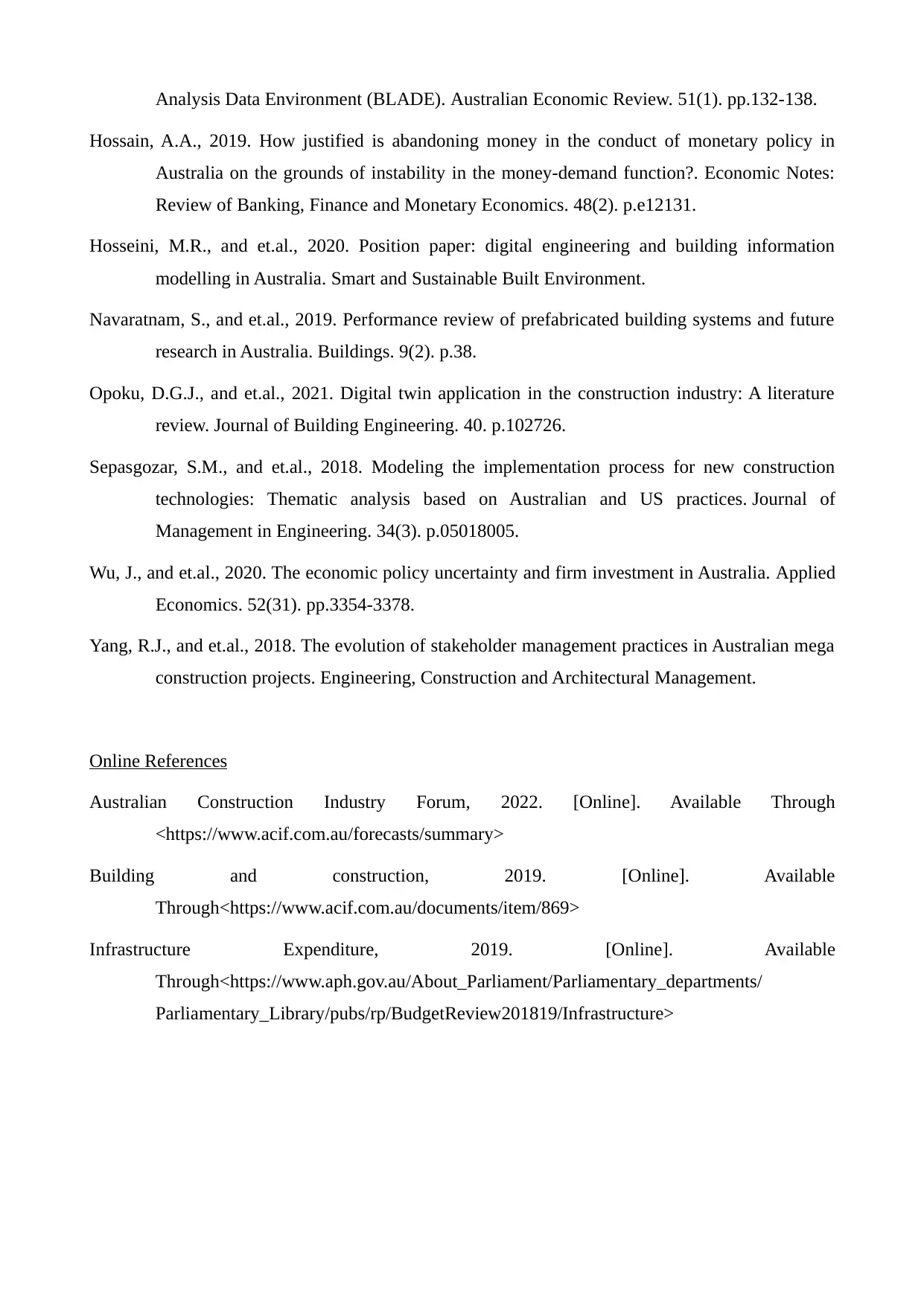
Analysis Data Environment (BLADE). Australian Economic Review. 51(1). pp.132-138.
Hossain, A.A., 2019. How justified is abandoning money in the conduct of monetary policy in
Australia on the grounds of instability in the money‐demand function?. Economic Notes:
Review of Banking, Finance and Monetary Economics. 48(2). p.e12131.
Hosseini, M.R., and et.al., 2020. Position paper: digital engineering and building information
modelling in Australia. Smart and Sustainable Built Environment.
Navaratnam, S., and et.al., 2019. Performance review of prefabricated building systems and future
research in Australia. Buildings. 9(2). p.38.
Opoku, D.G.J., and et.al., 2021. Digital twin application in the construction industry: A literature
review. Journal of Building Engineering. 40. p.102726.
Sepasgozar, S.M., and et.al., 2018. Modeling the implementation process for new construction
technologies: Thematic analysis based on Australian and US practices. Journal of
Management in Engineering. 34(3). p.05018005.
Wu, J., and et.al., 2020. The economic policy uncertainty and firm investment in Australia. Applied
Economics. 52(31). pp.3354-3378.
Yang, R.J., and et.al., 2018. The evolution of stakeholder management practices in Australian mega
construction projects. Engineering, Construction and Architectural Management.
Online References
Australian Construction Industry Forum, 2022. [Online]. Available Through
<https://www.acif.com.au/forecasts/summary>
Building and construction, 2019. [Online]. Available
Through<https://www.acif.com.au/documents/item/869>
Infrastructure Expenditure, 2019. [Online]. Available
Through<https://www.aph.gov.au/About_Parliament/Parliamentary_departments/
Parliamentary_Library/pubs/rp/BudgetReview201819/Infrastructure>
Hossain, A.A., 2019. How justified is abandoning money in the conduct of monetary policy in
Australia on the grounds of instability in the money‐demand function?. Economic Notes:
Review of Banking, Finance and Monetary Economics. 48(2). p.e12131.
Hosseini, M.R., and et.al., 2020. Position paper: digital engineering and building information
modelling in Australia. Smart and Sustainable Built Environment.
Navaratnam, S., and et.al., 2019. Performance review of prefabricated building systems and future
research in Australia. Buildings. 9(2). p.38.
Opoku, D.G.J., and et.al., 2021. Digital twin application in the construction industry: A literature
review. Journal of Building Engineering. 40. p.102726.
Sepasgozar, S.M., and et.al., 2018. Modeling the implementation process for new construction
technologies: Thematic analysis based on Australian and US practices. Journal of
Management in Engineering. 34(3). p.05018005.
Wu, J., and et.al., 2020. The economic policy uncertainty and firm investment in Australia. Applied
Economics. 52(31). pp.3354-3378.
Yang, R.J., and et.al., 2018. The evolution of stakeholder management practices in Australian mega
construction projects. Engineering, Construction and Architectural Management.
Online References
Australian Construction Industry Forum, 2022. [Online]. Available Through
<https://www.acif.com.au/forecasts/summary>
Building and construction, 2019. [Online]. Available
Through<https://www.acif.com.au/documents/item/869>
Infrastructure Expenditure, 2019. [Online]. Available
Through<https://www.aph.gov.au/About_Parliament/Parliamentary_departments/
Parliamentary_Library/pubs/rp/BudgetReview201819/Infrastructure>

1 out of 16
Related Documents
Your All-in-One AI-Powered Toolkit for Academic Success.
+13062052269
info@desklib.com
Available 24*7 on WhatsApp / Email
![[object Object]](/_next/static/media/star-bottom.7253800d.svg)
Unlock your academic potential
© 2024 | Zucol Services PVT LTD | All rights reserved.



